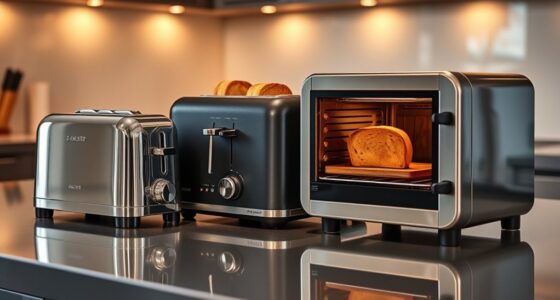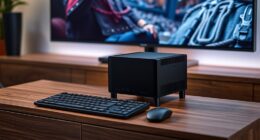A range hood keeps your kitchen air clean by removing smoke, fumes, and odors from cooking. It improves safety, reduces grease buildup, and helps maintain good air quality. When choosing one, consider the type, size, airflow capacity, and noise levels. Proper installation and maintenance are key for performance and safety. Want to discover how to pick the best model for your space? Keep exploring to find out more.
Key Takeaways
- A range hood improves indoor air quality by venting smoke, odors, and harmful gases from cooking.
- Proper selection and installation ensure effective ventilation tailored to your stove type and kitchen layout.
- Features like adjustable CFM, quiet operation, and smart controls enhance usability and comfort.
- Regular maintenance, including filter cleaning and duct checks, keeps the range hood functioning efficiently.
- Different styles and brands offer options from budget-friendly to luxury, matching your aesthetic and performance needs.
Understanding the Purpose of a Range Hood

A range hood is an essential kitchen appliance installed above your stove or cooktop that actively improves your indoor air quality. It works by drawing in smoke and fumes through a vent, helping to keep your kitchen cleaner and safer. The filters trap grease particles, preventing buildup on cabinets and walls, which reduces your cleaning efforts. Ventilation is key to removing heat, odors, and harmful gases like carbon monoxide, enhancing your overall cooking experience. A good range hood ensures that airborne pollutants don’t linger, maintaining better air quality in your kitchen. Proper ventilation design can significantly improve the effectiveness of your range hood and overall kitchen safety. Selecting a range hood with appropriate airflow capacity is also vital to ensure efficient removal of pollutants and maintain optimal air quality. Additionally, understanding cultural influences can help you choose a range hood that complements your kitchen’s style and your cooking habits.
Different Types of Range Hoods and Their Benefits
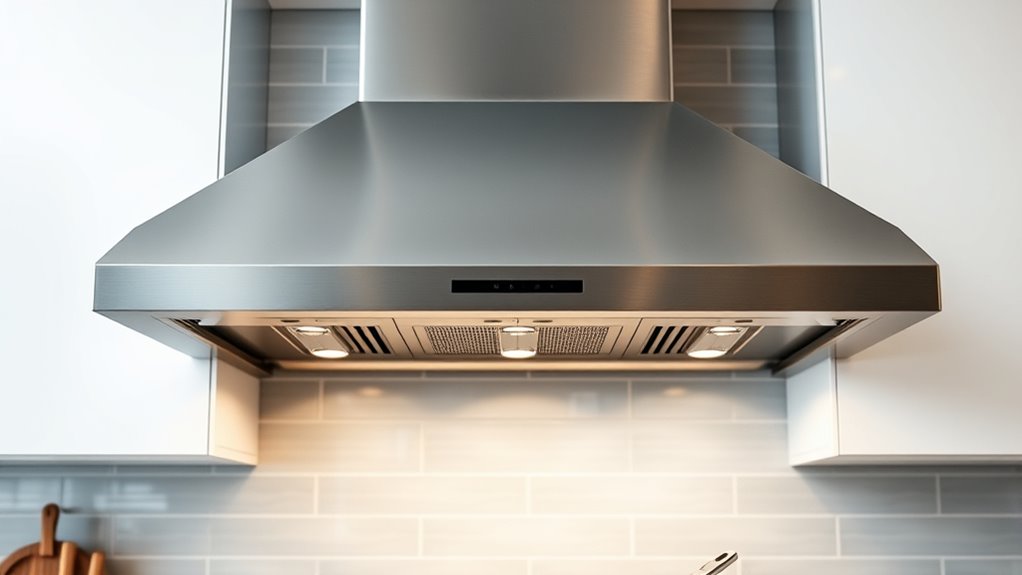
Choosing the right type of range hood depends on your kitchen layout and cooking needs. Different types include undercabinet, wall-mounted chimney, island, and downdraft hoods, each suited to specific spaces and cooking styles. For example, island range hoods hang from the ceiling and are wider for effective ventilation over island cooktops, while ducted hoods provide strong suction power and better airflow. Ductless hoods trap filters like charcoal to recirculate air when venting outside isn’t possible. Consider your kitchen space and high temperatures generated during cooking. Here’s a quick overview:
| Hood Type | Best For | Ventilation Style |
|---|---|---|
| Island Range Hood | Open kitchens, islands | Ducted or ductless |
| Wall-mounted Chimney | Spaces without cabinets | Ducted |
| Downdraft | Limited space, cooktop flexibility | Ducted |
Additionally, selecting a hood with suitable ventilation capacity ensures it can handle your cooking volume efficiently. Proper ventilation not only improves air quality but also prolongs the lifespan of your appliances and maintains a comfortable kitchen environment. Considering local building codes and regulations can help ensure your installation meets safety standards and optimizes performance.
Key Features to Consider When Choosing a Range Hood
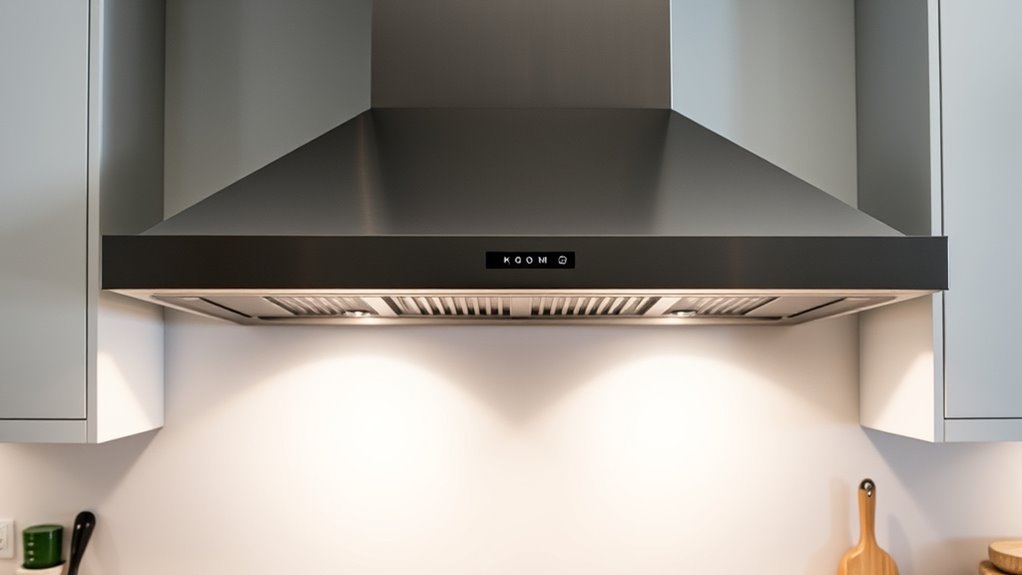
When selecting a range hood, focus on its ventilation capacity to match your cooking needs—heavier cooks should look for at least 350 CFM. Consider noise levels and control options like adjustable speeds and smart features to make operation more comfortable. Ensuring the right size, noise performance, and user controls helps maximize efficiency and convenience in your kitchen. Additionally, understanding the essential oils that can improve your kitchen environment through fresh scents and antibacterial properties can enhance your cooking space. Incorporating automation technologies into the kitchen can also streamline maintenance and operation, making your cooking experience more seamless. For those interested in optimal performance, exploring Kia Tuning options can provide insights into upgrading your vehicle’s efficiency and style to complement your kitchen upgrades.
Ventilation Capacity (CFM)
Ventilation capacity, measured in Cubic Feet per Minute (CFM), determines how effectively your range hood can remove smoke, odors, and grease from your kitchen air. A higher CFM means better airflow and more efficient smoke removal. For electric stoves, aim for at least 100 CFM per foot of cooktop width; for example, a 36-inch range requires a minimum of 360 CFM. Gas stoves need even more airflow—roughly 100 CFM per 10,000 BTUs of burner output—to vent combustion fumes properly. Selecting a range hood with the right CFM ensures your kitchen ventilation system works efficiently without excessive noise or energy use. Proper ventilation capacity helps prevent lingering fumes, keeps your air clean, and maintains a healthier cooking environment. Additionally, understanding organic and natural juices can inspire healthier kitchen environments and improve indoor air quality. When choosing a range hood, consider performance upgrades such as more powerful motors and quieter operation to optimize your cooking experience. Remember, the size and layout of your kitchen can also influence the ideal CFM for your needs, ensuring optimal air exchange. Incorporating advanced filtration systems can further enhance air quality by trapping smaller particles and odors, complementing the ventilation capacity.
Noise and Controls
Noise levels and control options are key factors that influence your overall kitchen experience with a range hood. Lower noise levels, often below 3 sones at maximum speed, create a quieter, more comfortable environment. Adjustable fan speeds, ranging from 3 to 6, let you tailor ventilation and noise to your cooking needs. Features like sound-dampening insulation and noise-reduction technology can further reduce operational noise, making your kitchen more peaceful. Incorporating noise-reduction technology into your range hood can significantly enhance your kitchen ambiance by minimizing disruptive sounds. According to the Value of Home Security Systems, reducing noise can contribute to a more relaxing and stress-free home environment. Implementing proper installation practices ensures optimal performance and helps prevent unnecessary noise issues. Control options such as variable speed switches, electronic touch panels, and remote controls offer precise operation and ease of use, helping you manage noise levels effortlessly. Balancing airflow with quiet operation ensures you get effective ventilation without sacrificing comfort, making these features essential when choosing your ideal range hood. Incorporating quality assurance practices during installation can help maintain consistent performance and longevity of your range hood. Additionally, selecting a range hood with appropriate exfoliating features can help improve overall kitchen air quality by reducing airborne particles and odors.
Factors Influencing the Right Size and Venting Method
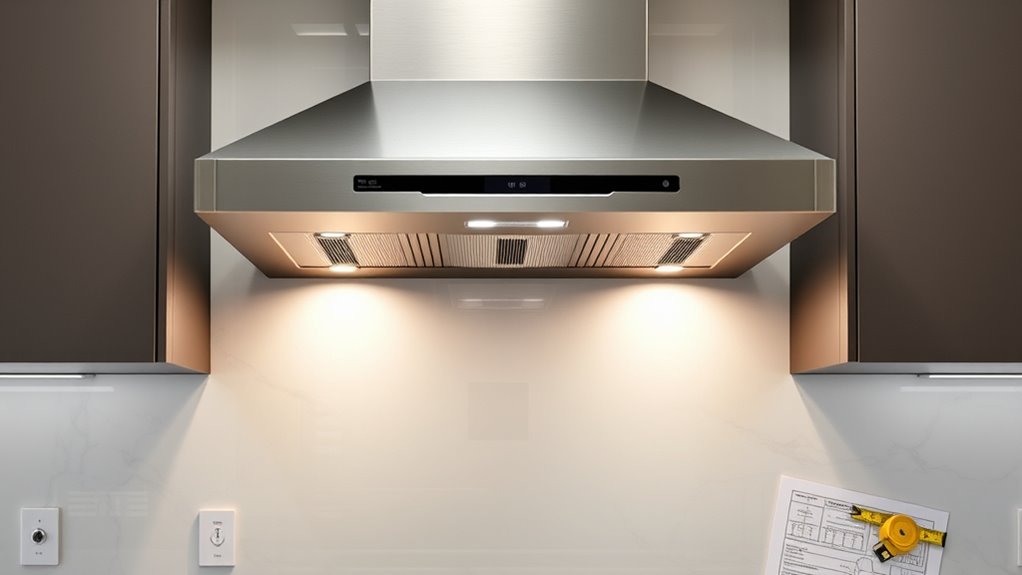
Choosing the right size and venting method for your range hood is essential for effective kitchen ventilation. Your range hood size should match or exceed your cooktop width, typically 30 to 66 inches, with island range hoods often wider by 3 to 6 inches to contain fumes. The venting method—ducted vs. ductless—impacts installation and efficiency; ducted hoods vent outside for maximum effectiveness, while ductless recirculate filtered air. Proper mounting height, usually 24-30 inches above the cooktop, ensures safety and airflow. The CFM rating must align with your cooktop’s BTU output and size, especially for heavy-duty cooking. Additionally, considering water-related features can enhance your overall kitchen experience, especially if you enjoy aquatic-themed decor or water features nearby. Incorporating smart technologies like sensor-activated controls can further optimize ventilation efficiency and convenience. It’s also important to assess installation complexity to ensure proper setup and maintenance. Feel confident choosing a hood that fits your space and cooking style—ensure safe, effective ventilation that keeps your kitchen fresh. Select the perfect venting method for your home setup.
Popular Brands and What Sets Them Apart
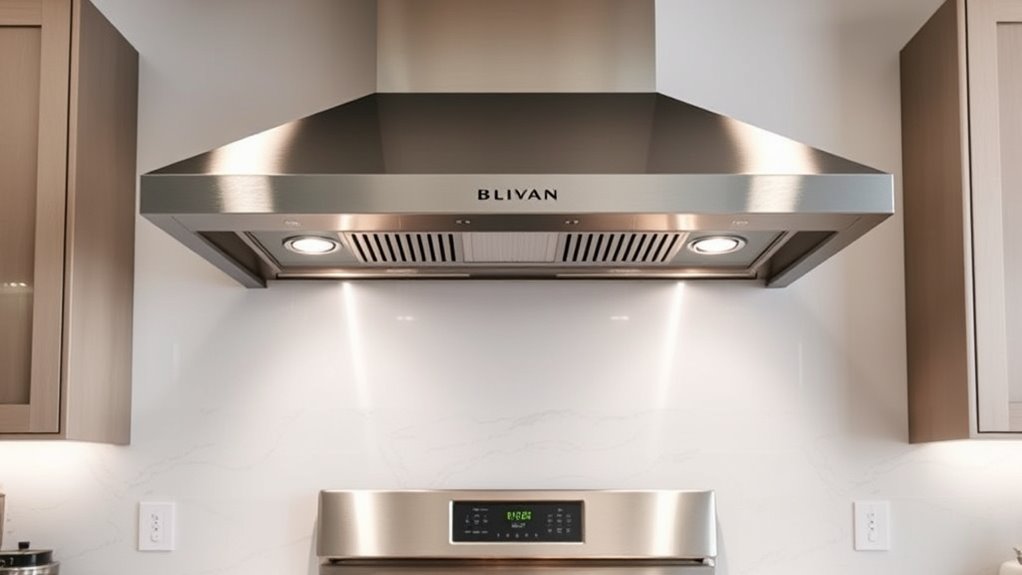
When choosing a range hood, you’ll notice a variety of brands offering different styles, features, and price ranges. Some brands focus on affordability and versatility, while others emphasize durability or high-end craftsmanship. Understanding what sets these brands apart helps you find the perfect fit for your kitchen needs.
Brand Variety and Range
A wide variety of brands offer range hoods to suit every budget and style, making it easier to find the perfect fit for your kitchen. Major brands like Broan-NuTone, GE, Vent-A-Hood, Viking, Whirlpool, and Zephyr provide an extensive range variety, from budget-friendly options to luxurious, professional-grade models. Broan-NuTone offers reliable, versatile selections available at retailers like Home Depot and Lowe’s, ensuring easy access. Vent-A-Hood specializes in high-end hoods favored by pros, often found at specialty stores. Viking’s luxury range hoods from 30 to 60 inches deliver professional performance, available through select retailers. GE’s dependable lines, including Profile and Monogram, cover all styles and price points, backed by a strong brand reputation that guarantees quality and longevity.
Price and Quality Options
Popular range hood brands cater to a wide range of budgets and needs, offering options from budget-friendly to luxury models. If you’re looking for high-quality range hoods, brands like Broan-NuTone and Whirlpool provide reliable, affordable choices, with stainless steel finishes and modern features. For those seeking luxury options, Viking and Vent-A-Hood deliver professional-grade, custom designs, often with larger widths and superior airflow. Whether you prefer ducted vs. filters every, these brands cover all bases. The table below highlights what sets each apart:
| Brand | Price Range | Key Features |
|---|---|---|
| Broan-NuTone | Budget-friendly | Wide selection, extensive configuration |
| Whirlpool | Mid-priced | Modern range, solid performance |
| Zephyr | Mid-priced | Stylish, reliable options |
| Viking | Luxury options | Premium materials, large widths |
Unique Features and Innovations
Innovative brands like Vent-A-Hood and Zephyr distinguish themselves with advanced blower systems that deliver high performance while operating quietly, making them ideal for busy kitchens. They incorporate innovative filtration systems such as self-cleaning filters and washable grease traps, simplifying maintenance and improving air quality. Many models feature smart technology, allowing you to control and monitor ventilation remotely via Wi-Fi or apps. Customizable lighting options, like dimmable LEDs, enhance your kitchen’s ambiance and visibility. Materials and finishes vary from sleek metals to textured surfaces, adding aesthetic appeal and durability. These features not only elevate your cooking space but also create a seamless, efficient experience.
- Feel confident with quiet operation that doesn’t disrupt your busy mornings
- Enjoy personalized ambiance with customizable lighting options
- Benefit from low-maintenance, innovative filtration systems that last
Ensuring Proper Installation and Maintenance

To guarantee your range hood operates safely and efficiently, proper installation and regular maintenance are essential. Ensure your hood is installed at the proper height, typically 24-30 inches above the cooktop, for effective ventilation and safety. Secure mounting and correct duct size are vital; use foil tape to seal duct joints, preventing air leaks and backdrafts. Regularly inspect your vent system and blower to confirm all components function properly, reducing fire risks and mechanical issues. Maintain airflow by cleaning and replacing filters, especially charcoal filters every 1-3 months. Proper maintenance and inspection keep your range hood performing at its best, guaranteeing clean air and a safe cooking environment.
Frequently Asked Questions
What Should You Look for in a Range Hood?
When choosing a range hood, you should look for one that matches or exceeds your cooktop width for better fume capture. Make sure it has a powerful blower with at least 350 CFM, especially if you cook with heavy or high-BTU ranges. Pick filters that are easy to clean or replace, and consider features like adjustable speeds, timed shutoff, and energy-efficient lighting. Proper installation height is also essential for safety and performance.
What to Look for When Buying a Rangehood?
When buying a range hood, you should match its width to or slightly larger than your cooktop, typically between 30-66 inches. Look for a blower with at least 350 CFM for moderate cooking or more for heavy-duty use. Consider whether you want ducted or ductless options, and check for features like multiple speeds, easy-to-clean filters, and adjustable lighting. Also, make certain of proper installation height and style coordination with your kitchen.
How Many Cfm for a Range Hood Do I Really Need?
Imagine you have a 36-inch electric stove; you’ll want at least 300 CFM to ventilate properly. For your range, the recommended CFM depends on size and cooking style. Gas ranges need higher ratings, around 100 CFM per 10,000 BTUs. Remember, more CFM isn’t always better—too much can be noisy. Match your hood’s airflow to your cooktop’s size and cooking habits for effective, quiet ventilation.
How to Choose a Range Hood Insert?
When choosing a range hood insert, you need to consider size, CFM, compatibility, and filters. Pick a size that matches your cooktop, usually 30, 36, or 48 inches wide. Make sure the CFM is sufficient for your cooking style—at least 350 CFM for regular use. Check if it fits your ducting or is suitable for ductless systems, and select filters like baffle or charcoal for effective air purification.
Conclusion
A range hood isn’t just a kitchen accessory—it’s your first line of defense against smoke, odors, and grease. While some believe a powerful vent is overkill, research shows proper ventilation can improve air quality and even boost your home’s value. So, investing in the right range hood isn’t just smart; it’s essential. Don’t wait until odors linger—make sure your kitchen stays fresh and safe with the perfect range hood today.





